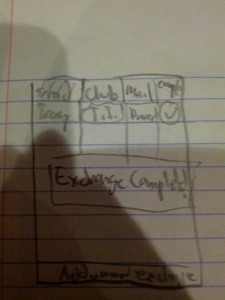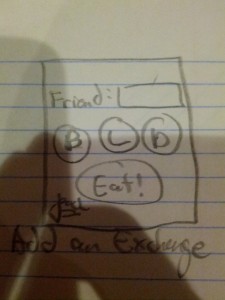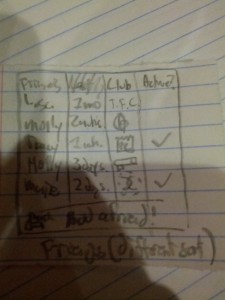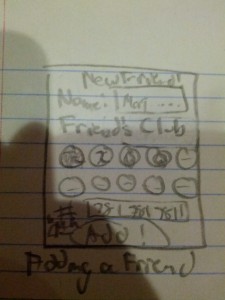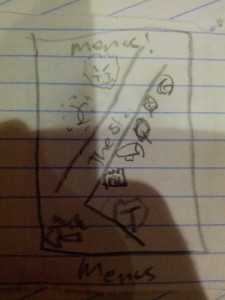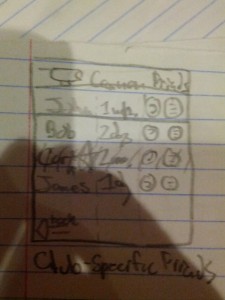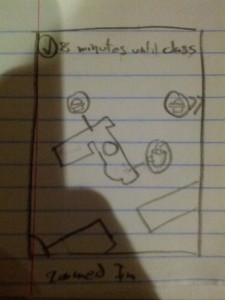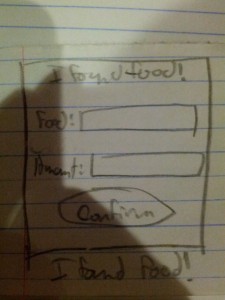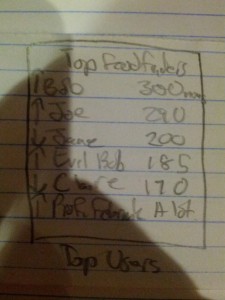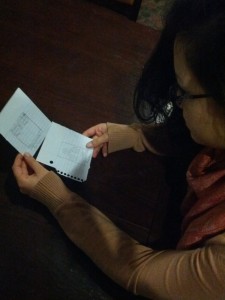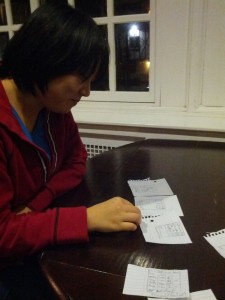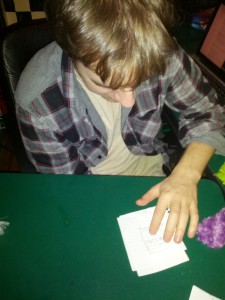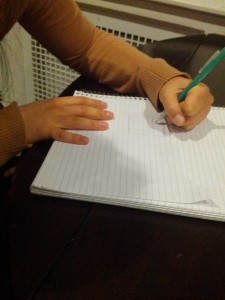Observations
I observed professors and students waiting in CS 104 and 105 for classes to begin throughout the day on Thursday. Most students arrived to class only a few minutes before lecture began, though many lectures started a few minutes late. Many of the students that arrived with substantial time to spare sat alone and used either a smartphone or laptop. As more students arrived, they began to congregate with their friends, discussing topics from problem sets to eating plans. Many complained about lack of sleep or missed meals. The professors I observed either examined their lecture slides while standing at the podium or chatted to students, though I was too far away to hear what about. I observed many students with larger screens visit Facebook, Reddit, Pinterest, PrincetonFML, the Daily Princetonian website, and Princeton Gmail. I talked to one close friend, after watching him use his smartphone for a few minutes. He was playing the GBA game Golden Sun on an emulator. He had not noticed me in the back of the lecture hall, and expressed that he would have liked to chat had he known I was there. Another friend that I briefly interviewed at the end of class indicated that she was looking for the closest study space, preferably one with access to vending machine food or coffee. We went to get coffee from the CS machine in the Tea Room, which she hadn’t known about. I walked with a third friend to check his mailbox at Frist while we talked. He typically spends the half an hour he has between class in CS and precept in 1879 playing chess with friends in the Terrace library, searching for free food if he hasn’t eaten lunch, or taking care of unanswered emails.
Any application that aims to involve large groups of students would have to support a widely varying number of participants, and elegantly handle students joining and dropping dynamically. As the number of students present in any lecture hall typically grows dramatically right before lecture starts, activities that take under three minutes are ideal. Friends I interviewed noted that they would often try to find their friends in smaller lecture halls if they arrived with plenty of time to spare, but would rarely do so in larger lecture halls. Activities for small groups might work, especially if they aimed to connect students, but would also have to find some way of including solo participants. Some expressed frustration at their inability to use the time between classes for anything other than random internet browsing, though others were able to regularly take care of small, important tasks or get ahead on reading if their classes were close enough.
Brainstorming
1. An smartphone application that allows students to plan meal exchanges at eating clubs with their friends and tracks where they have gone so that they can complete all of their exchanges before the end of the month.
2. An application that tracks emails that need a response and other small tasks and reminds users to take care of them in small amounts of free time.
3. A 1 vs. 100 style game with questions from the previous lecture to aid student memory and to help professors gauge comprehension.
4. An application that automatically matches students in groups to work in problem sets based on schedule and current progress.
5. A class-wide online arcade with many different 2-6 player games (tetris, tron, pac-man, bomberman, missile command) that tracks high scores and overall leaders.
6. A device that allows professors to poll the class on different short (1-3 minute) lectures on their own research or other interesting topics and displays slides for the winning topic.
7. A persistent massively multiplayer pokemon-style monster battling game that is only playable in the 10 minutes before class, which starts over every semester.
8. An application that matches students into 8-person groups and simulates drafting Magic: The Gathering.
9. An application that displays a random passage from the week’s reading, solicits short responses from all students present, and performs sentiment analysis to extract common themes, which the professor responds to.
10. An application that shows the locations of free food and coffee that can be reached in the time before class starts.
11. An application that tracks calories burned walking between classes so those long walks seem a little more rewarding.
12. An application to help students get to class on time that measures distance to class, average walking speed, and time to get ready in the morning and notifies users when they have to wake up and leave their current location.
13. A paired device for couples that lets them know when they are near each other and have a few minutes of free time.
14. An application that allows Psychology students and researchers to submit short surveys that can be taken for money by students waiting for class to begin.
15. An application that plays music from a professor’s playlist before lecture, allows students to vote on the songs they like, and suggests similar music for them to listen to as it learns their preferences.
I brainstormed with Clayton Whetung and Marjorie Lam.
Prototypes
I chose to prototype a meal exchange/planning program as a smartphone application, as incomplete meal exchanges are an unnecessary, expensive evil and such an application would encourage students to expand their social and gustatory circles. I also prototyped the food/coffee finding application as complaints about hunger and lack of sleep outnumbered any other conversation topic and many students are unaware of the free food and caffeine available all around campus.
My meal exchange application as prototyped has three main screens.
The first shows meal exchanges in progress, and allows users to mark ones they have completed.
The second is a list of friends that users can add to that allows users to browse their friends by name, time since last exchange, and club, and also displays those users with whom the user has an active exchange.
The third displays a map of the street with logos of each club.
A touch of the logo brings up a menu and a button that allows users to find friends in that club. They can then call or text these users.
Contextual popups let users see friends in the same lecture hall to grab a meal with after class.
My free food application as prototyped, shows a map centered on the user with locations of free food and coffee marked with icons.
These icons, when touched by the user, show further details about the food and the approximate time to reach it.
The time until the user’s next class starts is displayed at the top on most screens. The user can zoom the map in and out, and a circle noting the furthest distance that can be reached with time to walk to class is noted.
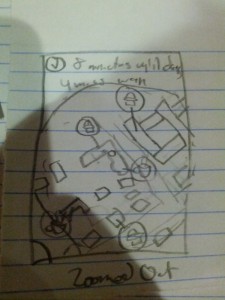
A menu allows users to report new free food, which brings up a form to do so, or indicate that the food/coffee has run out.
The application tracks top contributors on a leaderboard.
I tested the meal exchange application with fellow students Marjorie Lam, Yingxue Li, and Tim Kunisky.
Each has a very different style of meal exchanges, but their searches through the paper prototypes proceeded very similarly. All made their way through the main features of the application, exploring the options and experimenting with adding and completing exchanges, adding friends, etc.
Marjie does on the order of 4-5 meal exchanges in the average month, mostly with former roommates. She proceeded through all of the available options on the application, noting that as time between classes was limited, it would be best if the application could quickly suggest meal exchanges to you with friends you had not performed an exchange with in the longest time or those whom you needed to complete exchanges with at the next meal.
Many of her comments focused on the application’s ability to help users track their current exchanges and complete them before the end of the month. She noted that even with the limited number of exchanges she does, she often found herself scheduling many exchanges in the last few days of each month and struggling to be able to complete them all. To this end, she suggested a further revision of the application could notify users as the end of the month is approaching, or use its knowledge of a group of friend’s remaining exchanges to create a schedule that completes everyone’s exchanges.
Yingxue, as an independent student, does not have meal exchanges, but noted that independent students could still take advantage of such an application by exchanging guest meals at eating clubs for dinners hosted in independent housing. She personally takes advantage of guest meals at eating clubs as often as possible, on the order of 3-4 times a week. She noted that there were perhaps on the order of a dozen friends she would feel comfortable contacting in this way, but that she enjoyed eating meals with those friends she saw less frequently when they offered. She also suggested an extension of the application to students who primarily eat in the dining halls. Even as an independent, she sometimes forgot to use her 2 free dining hall meals a week, and thought that the application could help her to remember those. While I was encouraged by the alternatives Yingxue suggested, I thought that expanding the scope of the application too much could dilute the effectiveness and would necessarily make the user experience more cluttered.
Tim, while exploring the application, noted that he infrequently eats meals in clubs other than Terrace, exchanging eating club meals once or twice a month. While he has many friends in other clubs, he is often rushing between classes in the middle of the day and works primarily in Terrace in the evening. He more frequently exchanges with his friends on dining hall meal plans, which he noted was not supported by the prototype. He especially liked the feature of the application that created a contextual pop-up for friends who were in close proximity, and suggested that users could upload their schedule and find students to exchange with in the same classes, who might be leaving class together or want to work on assignments over a meal. Tim’s comments suggested to me that the application might have real potential for encouraging users to eat outside their clubs, but concerns surrounding privacy would limit the scope of the networks created using the application. Tim noted that though he would like to, he has trouble getting his sophomore year roommates together for a meal, as they are all in different clubs. He suggested that the application help users cycle through larger meal exchanges with groups. Marjie expressed a similar sentiment.
Insights
- The social networks of meal exchanges are small and dense, mostly consisting of former roommates and close friends from freshman year, but an application could help to expand them as students are comfortable exchanging with less close friends.
- The primary motivation for Princeton students to use such an application is not losing money on incomplete meal exchanges.
- Students do not have extensive amounts of time in between classes to browse menus, etc. Those clubs they want to eat at are those where they have incomplete exchanges for the next meal.
- Meal exchanges are currently only feasible as a one-on-one activity, but students would like to have meals with larger groups, which an application might help support.
- Users would like to track dining hall meal exchanges and free dining hall meals as well as club meal exchanges, but liked the simplicity of the application as presented.



